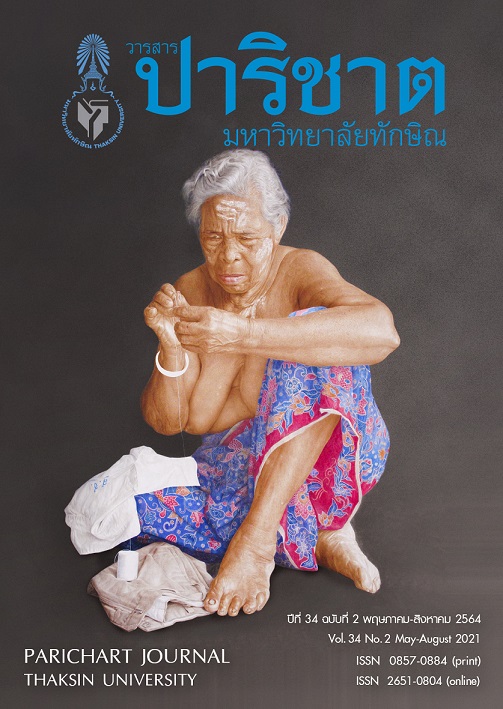Graven Image Making Process and Definition of Kim Sin Idolatry Sculpture in Ritual Areas
Main Article Content
Abstract
This article is part of a research on “Kim Sin and Ma Song: Deity and humanity in the Chinese ritual areas of Phuket Province” by studying Kim Sin idolatry on the issues of graven image making process and the definition of idolatry sculpture in the ritual areas of Phuket Vegetarian Festival. Therefore, the researcher collected the field data in the shrine during Phuket Vegetarian Festival by means of in-depth interviews in regard to Kim Sin image sculpture and those devotees involved in performing rituals in the shrine through participatory observation and non-participatory observation within the research areas resulting in the form of descriptive research. The results revealed that 1) Chinese people have traditional beliefs in respecting ancestral spirits that exist in nature becoming an “Ancestral Worship of Spirits Sect” which holds and obeys ancestors ancestors by worshipping Godlike idols, which leads to the making of Kim Sin idolatry to be an image that creates spiritual value, 2) The creation of Kim Sin is a carving technique that deciphers humanity from myths or historical tales that the carver created in accordance with the story, including shapes, proportions, faces as well as the use of symbols corresponding to such God, and 3) Kim Sin creates social phenomena of the Thai Chinese through rituals as in the vegetarian festival that has made Phuket the “Sacred Place” particularly dedicated to performing rituals.
Article Details
References
Boonmee, T. (2008). Ferdinand de Saussure’s Revolution of Postmodernism. Bangkok: Vibhasa. (In Thai)
Soonpongsri, K. (2008). Chinese Art History (3rd ed.). Bangkok: Chulalongkorn University. (In Thai)
Santasombat, Y. (2005). Power, Space and Ethnic Identities : Cultural Politics of Nation – State in Thai Society. Chiang Mai: Faculty of Social Sciences. (In Thai)
Chuenpimonch, S. (Interviewee), Pinnukul, P. (Interviewer), Address: Jui Dtui Dtao Bo Geng Shrine, Ranong Road, Talat Nuea District, Mueang County, Phuke Provincet. October 8-10, 2018. (In Thai)
Manujantarat, S. (Interviewee), Pinnukul, P. (Interviewer), Address: Jui Dtui Dtao Bo Geng Shrine, Ranong Road, Talat Nuea District, Mueang County, Phuke Provincet. October 8-10, 2018. (In Thai)
Baudrillard, J. (1981). Simulacres et Simulation. Paris: Galilee.
Watanamahat, K. (2011). Guide to Worshiping God (3nd ed.). Bangkok: Sangsan Book. (In Thai)
Barthes, R., & Prachakul, N. (2008). Myth. Bangkok: kobfai. (In Thai)
Feungfusakul, A. (2003). Identity, Theory and Conceptual Review. Bangkok: The National Research Council of Thailand. (In Thai)
Singyabuth, S. (2003). Visual Arts Review. Bangkok: Odeon Store. (In Thai)
Rakyaw, C. (Interviewee), Pinnukul, P. (Interviewer), Address: Wichit Songkram Road, Kathu District, Kathu County, Phuke Provincet. December 25, 2018. (In Thai)
Buthlop, T. (Interviewee), Pinnukul, P. (Interviewer), Address: Tarn Tong Villa, Wichit District, Mueang County, Phuke Provincet. June 15, 2018. (In Thai)
Juntaronanont, N. (2003). The Chinese Way. Bangkok: praphansarn. (In Thai)
Lawin, Y. (Interviewee), Pinnukul, P. (Interviewer), Address: Sam-Ong Hu Shrine, Choeng Thale District, Thalang County, Phuket. Phuke Provincet. October 15-18, 2018. (In Thai)
Aekphol, P. (Interviewee), Pinnukul, P. (Interviewer), Address: Jui Dtui Dtao Bo Geng Shrine, Ranong Road, Talat Nuea District, Mueang County, Phuke Provincet. October 15-16, 2018. (In Thai)
Panin, O. (1987). The symbolism Represents Various Meanings in Chinese Temples, NAJUA: Architecture, Design and Built Environment Faculty of Architecture, 7, 80-104. (In Thai)
Jitakasem, N. (2015). Significance Creation for Gigantic Religious Object of Worship Between 1991-2014. Unpublished Ph.D. Dissertation. Burapha University. (In Thai)
Suksai, N. (2009). The process of meaning and value creations of Jatuakarmramathep in the contexts of commercial society. Unpublished Master’s Thesis. Walailak University. (In Thai)


